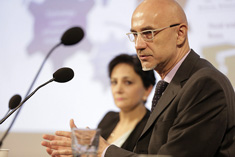-
How to Translate Paris Pledges Into Action? Regulatory Frameworks, Says World Bank’s Grzegorz Peszko
June 24, 2016 By Sean Peoples
Nearly six months after the Paris climate agreement, the international community’s attention has shifted from celebration to implementation. Governments have begun outlining climate pledges in the form of intended nationally determined contributions, or INDCs – which are fast becoming nationally determined contributions, or NDCs, as they begin influencing policy.
Nearly six months after the Paris climate agreement, the international community’s attention has shifted from celebration to implementation. Governments have begun outlining climate pledges in the form of intended nationally determined contributions, or INDCs – which are fast becoming nationally determined contributions, or NDCs, as they begin influencing policy.
The composition and quality of individual INDCs and NDCs vary country to country. In this week’s podcast, Grzegorz Peszko, lead economist in the climate change group of the World Bank, outlines the types of plans submitted so far and how the World Bank is supporting implementation by individual governments.
Governments never have one instrument to achieve certain targetsThe first type of INDC tends to be too qualitative and lacks the quantitative rigor expected, which Peszko says can be indicative of government capacity issues, fear of commitment, or for strategic reasons. “These countries usually request assistance in framing their targets,” he says. Additionally, mitigation is a common challenge for these governments, especially if they have developed a comparative advantage in fossil fuel exports or in energy-intensive industries.
The largest proportion of submitted plans, and the second type Peszko mentions, are the most aspirational in their objectives. They run the gamut of emission reductions, increasing renewables in the energy mix, energy efficiency, and energy transport. “What is common to them is they face a challenge of implementation,” he says. By including a laundry list of new technologies or aspirational goals without capacity or planning, these countries may struggle to reach their targets.
The last type has sophisticated targets that are also “investment ready” for financiers like the World Bank, Peszko says. Yet, it’s also important these plans have an “incentive structure behind them,” with secondary regulations and an enforcement structure that “really changes the behavior of the people in a way that it makes sense to implement the law and behave in accordance to the law.”
Creating those incentives via regulations is the real challenge of harmonizing and strengthening climate pledges, says Peszko. The role of the government “is really to create this enabling policy framework” that is consistent with INDC and NDC targets.
“Governments never have one single instrument to achieve certain targets,” Peszko says. “There’s always a bundle, a package of instruments that need to be tweaked on the margins to make a change.”
Grzegorz Peszko spoke at the Wilson Center on June 14, 2016.
Friday Podcasts are also available for download on iTunes and Google Podcasts.
 A Publication of the Stimson Center.
A Publication of the Stimson Center.







